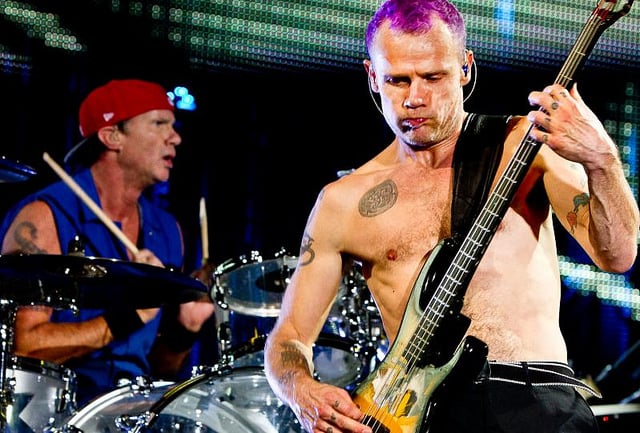
After funk-rocking for nearly 35 years, the Red Hot Chili Peppers have certainly accumulated a diverse fanbase. Last month, parents and children, fans alike, flooded into Oakland’s Oracle Arena, most donning red-asterisk T-shirts from performances past. Whether they were carrying a drink already or patiently waiting to overpay for one, the older fans started to bubble with anticipation, talking up the Red Hot Chili Peppers live exuberance to the uninitiated masses.
As show time neared, expectant eyes turned to the stage, and a hooded figure approached. Who is this menacing figure? Oh, it’s Flea. Grabbing the microphone, the renowned bassist enthusiastically introduced the night’s first opener, Jack Irons, who was the Chili Peppers’ founding drummer in 1983. While he was replaced for the band’s first two studio efforts, he returned to help record 1987’s “The Uplift Mofo Party Plan.” However, on account of the unexpected death of guitarist Hillel Slovak, he left and was soon replaced by current drummer Chad Smith, right before the band’s breakout record “Mother’s Milk” launched the group into a nearly 30-year mainstream career.
Despite Irons’ role as the Chili Peppers’ Pete Best, not many seemed to know what to really think of him, and given Flea’s vague introduction, only well-versed fans knew his RHCP past. As he took the stage, the lights revealed a drum set and a laptop. Rather than mimic the iconic Red Hot Chili Pepper sound he helped create, Irons played with sonic and visual psychedelics, with the large screen behind him overlaid with trippy, kaleidoscope color effects and old scenes from cinema’s Golden Age.
Although much of the performance was based on the anachronistic combination of ‘30s films and ‘60s visuals, Irons managed to sound fresh and modern while still playing off the old-fashioned graphics. The combination of his drumming and his pre-made instrumental phrases created a sound that ranged from chill steel drumming to industrial electrorock, reaching electronic levels nearing dubstep at some points. After starkly ending his set and offering some authentic gratitude to the crowd, he quietly stepped aside.
Soon after, Trombone Shorty and his band, Orleans Avenue, took the stage in a whirlwind of jazz and hard rock. Where Irons hid behind his drum set and laptop, Trombone Shorty immediately engaged the crowd and brought them to their feet. Playing through a diverse set list that included completely reworked versions of Green Day and Rage Against the Machine tracks, Trombone Shorty delivered an energized performance to the point of literal exhaustion, at one point holding a trumpet riff for nearly two minutes in one breath. Shorty and company gave it their all to create a sound heavily focused on exploiting the most primal aspects of jazz and metal, an apt opener to electrify the crowd before the Chili Peppers took the stage.
After several minutes of today’s hits played over the PA system between acts, the audio and lights abruptly cut out and the audience began to cheer in anticipation. A nearly shirtless figure approached the stage. Who is this menacing figure – oh, it’s Flea again. Joined onstage by the fully clothed drummer Chad Smith and guitarist Josh Klinghoffer, Flea initiated a smooth psychedelic intro jam, feeding off the psychedelic energy Jack Irons previously fostered in his set. Setting a pattern for the rest of the night, the band seamlessly transitioned the jam session into their first song of the evening.
Singer Anthony Kiedis, also fully clothed, joined the rest of the band to play the “Californication” 1999 hit “Around The World.” As the band launched into the song’s familiar chorus, the lifeless lights that had loomed over and perplexed the audience illuminated for the first two sets and began to move – yes, really move.
The swarm of lights moved as one and accentuated the performance. At many points, the lights extended the images displayed on the main screen, fully taking advantage of their unique motor ability to create a truly mesmerizing wavy effect. Although distracting at first, the movement of these lights helped add a unique, albeit slightly gimmicky, dimension of audience engagement.
The rest of the performance went off without many hitches. Each song was hilariously punctuated and introduced by intra-band banter, very often including an ever-unhinged Flea. The home state show likely meant a lot to the band, as California worms its way into much of their lyrics and even the title of their 1999 hit record “Californication.” While the Chili Peppers performed the strongest cuts off of their most recent album, “The Getaway,” released last year, they kept their relatively unknown new material at a minimum, purposefully leaving out songs from their lackluster 2011 effort “I’m With You.” The Chili Peppers came to entertain longtime fans rather than promote new material, opting to perform nearly two-thirds of their set list from their more well-known, 20th-century material.
As Kiedis finally indulged the audience’s shirtless expectations and took off his tee for the expected encore, one couldn’t help but reflect on the authenticity of the band’s control of the show’s energy. At some points it felt a bit too calculated and stilted, be it through seemingly rehearsed “impromptu quirky band banter“ or the almost pander-y shoutouts to “Oakland!” Either way, while I will never forgive Oracle Arena security guards for not letting people dance during “Give It Away,” Red Hot Chili Peppers without a doubt established themselves, at an average age of about 50, as one of the most consistently exciting, wild live acts in rock music today.
Contact Dylan Grosz at dgrosz ‘at’ stanford.edu.
